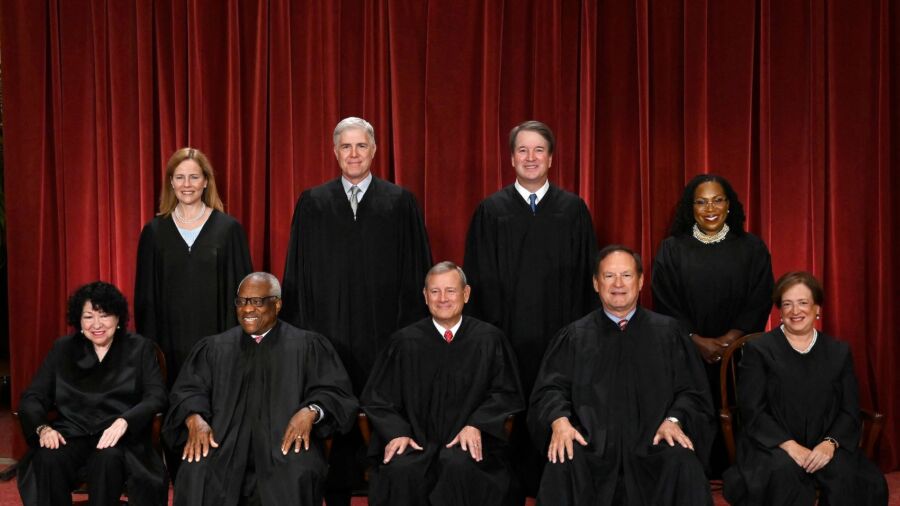The Supreme Court ruled 6-3 on June 22 that obstruction of justice is a serious enough crime to justify the deportation of lawful permanent residents—also known as green card holders—who have been convicted of it.
The somewhat technical new decision is expected to make it easier for the federal government to deport certain lawful U.S. residents convicted of crimes even if they have been living in the country for years.
Justice Brett Kavanaugh wrote the majority opinion in Pugin v. Garland (court file 22-23). Joining the opinion were Justices Clarence Thomas, Samuel Alito, Amy Coney Barrett, Ketanji Brown Jackson, and Chief Justice John Roberts. Jackson wrote a separate opinion concurring with the judgment of the court.
Justice Sonia Sotomayor wrote a dissenting opinion that two other justices joined.
The case involves Jean Francois Pugin, a citizen of Mauritius who was admitted as a U.S. permanent resident in 1985, and Fernando Cordero-Garcia, a citizen of Mexico who was admitted in 1965.
Pugin was convicted under Virginia law of being an accessory after the fact to a felony in 2014. Cordero-Garcia was convicted in 2009 under California law of various offenses, including dissuading a witness from reporting a crime.
But a so-called circuit split occurred when federal courts of appeal arrived at opposite conclusions as to whether the individuals’ actions fell under the definition of an aggravated felony because at the time of the commission of the permanent residents’ offenses, official investigations related to those crimes were not yet underway.
The U.S. Department of Homeland Security (DHS) pursued the removal of both men, arguing they were deportable because they had convictions for aggravated felonies related to obstruction of justice. In both cases, immigration judges and the Board of Immigration Appeals found for DHS. The men appealed.
The U.S. Court of Appeals for the 4th Circuit determined that Pugin’s conviction constituted an offense related to obstruction of justice. The U.S. Court of Appeals for the 9th Circuit went the other way, finding Cordero-Garcia’s conviction for a kind of witness tampering was not an offense related to obstruction of justice because the California law did not require that an investigation or a legal proceeding was pending at the time the predicate offense was committed.
Justice Kavanaugh wrote (pdf) for the majority that federal law “provides that noncitizens convicted of an ‘aggravated felony’ are removable from the United States.”
The definition of aggravated felony includes federal or state offenses “relating to obstruction of justice.”
“The question here is whether an offense ‘relat[es] to obstruction of justice’ under [the Immigration and Nationality Act, or INA] even if the offense does not require that an investigation or proceeding be pending. That question arises because some obstruction offenses can occur when an investigation or proceeding is not pending, such as threatening a witness to prevent the witness from reporting a crime to the police,” Kavanaugh wrote.
“We conclude that an offense may ‘relat[e] to obstruction of justice’ under [the INA] even if the offense does not require that an investigation or proceeding be pending.”
An “extensive body of authority” on the legal issue, including “dictionaries, federal laws, state laws, and the Model Penal Code” supports the court majority’s position, the justice wrote.
“Individuals can obstruct the process of justice even when an investigation or proceeding is not pending.
“For example, a murderer may threaten to kill a witness if the witness reports information to the police. Such an act is no less obstructive merely because the government has yet to catch on and begin an investigation.
“As the Solicitor General [Elizabeth Prelogar] persuasively states, one can obstruct the wheels of justice even before the wheels have begun to move; indeed, obstruction of justice is often ‘most effective’ when it prevents ‘an investigation or proceeding from commencing in the first place.’”
The Supreme Court affirmed the 4th Circuit’s ruling regarding Pugin and reversed the 9th Circuit’s decision regarding Cordero-Garcia, remanding the latter case to that circuit court “for further proceedings consistent with this opinion.”
Justice Jackson wrote that she agreed with the majority that the 9th Circuit “wrongly embraced a pending-proceeding requirement” and that the 4th Circuit “rightly rejected any such pending-proceeding requirement.”
Jackson said there may be a “reason why a predicate offense need not have a nexus to a pending or ongoing investigation or judicial proceeding in order to qualify as ‘an offense relating to obstruction of justice’ within the meaning of this immigration statute.”
“[W]hen Congress inserted the phrase ‘offense relating to obstruction of justice’ into [the INA] it might well have been referencing a specific and previously designated category of offenses—the offenses that are grouped together in Chapter 73 of Title 18 of the U.S. Code, under the heading ‘Obstruction of Justice.’ … And not all of the offenses that are addressed in Chapter 73 contain a pending-proceeding requirement,” the justice wrote.
Justice Sotomayor disagreed with the court majority and filed the sole dissenting opinion. It was joined in full by Justice Neil Gorsuch and in part by Justice Elena Kagan.
“From early American laws, to dictionaries, to modern federal and state obstruction statutes, interference with an ongoing investigation or proceeding is at the core of what it means to be ‘an offense relating to obstruction of justice.’ …
“The Court circumvents this ample evidence only by casting a wide net and then throwing back all but the bycatch. That approach ‘turns the categorical approach on its head,’ … and subverts the commonly understood meaning of ‘obstruction of justice’ when Congress enacted [a section of the INA] in 1996.”
From The Epoch Times


